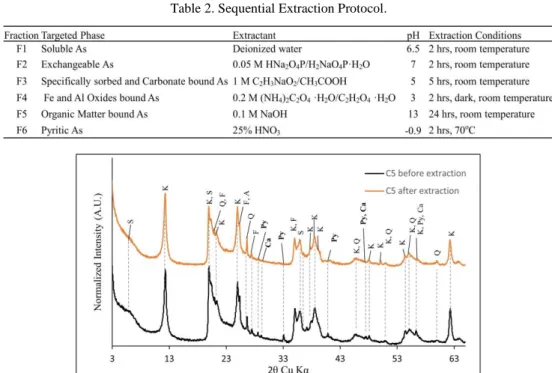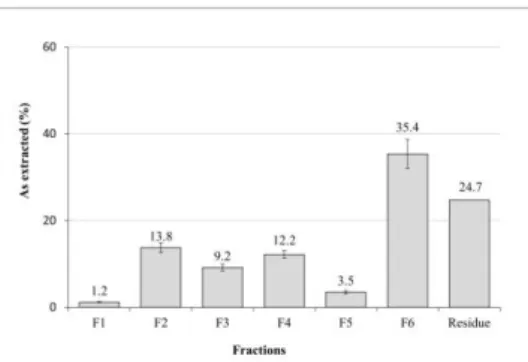HAL Id: hal-02499781
https://hal.archives-ouvertes.fr/hal-02499781
Submitted on 5 Mar 2020
HAL is a multi-disciplinary open access
archive for the deposit and dissemination of
sci-entific research documents, whether they are
pub-lished or not. The documents may come from
teaching and research institutions in France or
abroad, or from public or private research centers.
L’archive ouverte pluridisciplinaire HAL, est
destinée au dépôt et à la diffusion de documents
scientifiques de niveau recherche, publiés ou non,
émanant des établissements d’enseignement et de
recherche français ou étrangers, des laboratoires
publics ou privés.
To cite this version:
Rana Mhanna, Aude Naveau, Maïté Bueno, Laurent Caner, Joseph Bassil. Distribution of arsenic
in an argillaceous sample using sequential chemical extractions: application to the
Hydrogeologi-cal Experimental Site of Poitiers (HESP). 16th International Symposium on Water-Rock Interaction
(WRI-16) / 13th International Symposium on Applied Isotope Geochemistry (1st IAGC International
Conference), Jul 2019, Tomsk, Russia. pp.1-4, �10.1051/e3sconf/20199809018�. �hal-02499781�
Distribution of arsenic in an argillaceous
sample using sequential chemical extractions:
application to the Hydrogeological Experimental
Site of Poitiers (HESP)
Rana Mhanna1,*, Aude Naveau1, Maité Bueno3, Laurent Caner1, and Joseph Bassil2 1CNRS, Université de Poitiers, 86073 Poitiers CEDEX 9, France
2L2GE, Lebanese University, Faculty of Sciences, Fanar, Matn, Lebanon 3CNRS/ Université Pau & Pays de l’Adour, 64053 Pau Cedex 9, France
Abstract. Arsenic mobility and transport into groundwater is highly
dependent on its chemical distribution in sediments. In this study, a combination of sequential extraction and mineralogical investigation by X-ray diffraction on a sample collected from the hydrogeological experiment site of Poitiers (France) was tested to evaluate and predict the mobility of arsenic in different conditions. Results showed that the highest fraction of As (~35 %) was released by 25 % nitric acid however this fraction is poorly mobile under natural chemical conditions due to its high stability. Exchangeable As (~14 %) and As bound to iron and aluminium oxides (~12 %) exhibited a significant fraction that could be of high concern in case of change in the ionic composition and redox conditions, respectively. Soluble fraction comprised only 1 % of As which was in accordance with the composition of groundwater in the site.
1 Introduction
Arsenic (As) is a metalloid that has gained an increasing attention in the last decades due to the growing awareness of its toxic effect on human health [1]. High exposure to As, mainly via drinking water, is associated with various types of cancer, cardiovascular, neurological and other types of diseases [2]. According to the European standards, arsenic contamination of ground water occurs when its total concentration exceeds the value of 10 µg/L [3]. There are many sources of arsenic in waterbodies, some are geogenic such as mobilization from sediments while others are anthropogenic such as mining and agricultural runoff. The toxicity of arsenic relies in its known mobility under a wide range of pH and redox conditions. In sediments, arsenic can be linked to several solid phases that might be solubilized under certain changes in groundwater conditions causing the release of the associated arsenic through desorption or dissolution [4]. Hence, in order to predict arsenic’s mobility and bioavailability, it is of great importance to determine its distribution and chemical associations in sediments rather than only measuring its total concentration [5].
significant concentration of arsenic (~22 mg/Kg). The obtained results from sequential extraction experiments were discussed considering complementary mineralogical investigation.
2 Sequential extraction
Sequential extraction is a method used for solid phase partitioning that comprehensively investigate contaminant’s distribution in soils and sediments [7]. It requires the use of several extraction solutions having increasing chemical strength to target different components.
Sequential extraction is a relatively simple method that gives a better idea on the behavior of contaminants under different conditions which can improve the understanding of factors controlling them. In addition, it provides detailed information about the mobility and thus the transport of the studied contaminants into waterbodies [8]. However, some of its drawbacks might include the redistribution of the analyte among different phases and the formation of new precipitates during extraction, re-adsorption of the analyte, poor selectivity of some reagents and possible overestimation of some phases [6].
Several extraction schemes for arsenic fractionation were developed, with a huge discrepancy among number of steps, extraction solutions and conditions utilized. Nevertheless, the common feature among the different studies is that fractions are operationally defined. Arsenic can be associated with several solid phases such as iron and aluminium oxides, carbonated minerals, pyritic materials, clay minerals and organic matter [9]. Hence, it is of great importance to target these solid constituents in order to release the associated arsenic.
3 Materials and methods
3.1 Study area
Sediment used in this study was collected from the hydrogeological experimental site of Poitiers (HESP). This site is located 2 km south west of Poitiers city in France and consists of an area of 10 ha where 37 wells were cored through the Middle Jurassic (Dogger) and infra-Lias aquifers separated by the marls of the supra-infra-Lias. HESP is an operational scientific platform that hosts national and international scientific projects in the aim of developing new approaches in the characterization and modelling of groundwater flows [10].
The studied sediment was of black argillaceous nature, collected from C5 well through a non-destructive drilling in 2012 in the Dogger aquifer of the HESP at a depth between 66 and 71 m and corresponds to karst filling materials dated from the Upper Cretaceous (for more details on sediment sampling and preservation, reader can refer to articles [10] and [11]). This sediment was particularly chosen due to its enrichment in arsenic (~22 ppm) even though the value of arsenic in the water of the correlated site was below the detection limit.
3.2 Methodology
Sediment used in this study is a powder obtained by grinding and sieving at 200 µm. During extraction experiments, 0.6 g of C5 sediment was added to a 50 mL centrifuge tube along with 20 mL of extraction solutions. Tubes were agitated using a magnetic stirrer at a speed of 350 rpm then centrifuged at a speed of 14000 rpm for 10 mins (i.e. 21900 g). After that, supernatant was recovered and the subsequent extraction solution was added to the same solid residue. The residue obtained from the extraction experiments was oven-dried for 1 week at 105 oC and ground with an agate mortar and pestle. In order to identify the
change in the mineralogy of the sediment, comparison between X-ray diffraction patterns before and after extraction was conducted and shown in Figure 1. Powder samples were analyzed through X-ray diffraction using Philips Panalytical X’pert Pro apparatus equipped with Copper radiation of wavelength 1.5418 Å, scanning from 3-65o 2θ. Elemental analysis
of C5 sediment was conducted at SARM laboratory (CRPG-CNRS, Nancy, France) and is summarized in Table 1. The used protocol was adapted through modifications of the previous protocols [7, 10, 12]. A summary of the applied protocol is shown in Table 2. Aliquot from each fraction was analysed for arsenic using inductively coupled plasma mass spectrometry (ICP-MS; Agilent 7500ce). Residue value was calculated from the difference between the total arsenic and the sum of the extracted fractions.
Table 1. Chemical composition of C5 sediment.
Table 2. Sequential Extraction Protocol.
Fig. 1. XRD patterns before and after extraction of C5 sediment (A: Anatase, Ca: Calcite, F: Feldspar,
exchange between arsenate and phosphate ions due to the similarity of their electron configuration however, the smaller size and higher charge density of phosphate causes the desorption of arsenate [13]. Exchangeable arsenic is an easily mobilized fraction, hence a significant amount of As can be directly released under a change of ionic composition or pH [8]. A value of 9.2±0.8 % of total As was extracted with acetate buffer (F3) and a post extraction analysis showed 100% release of calcium ions. Considering the low amount of calcium in the sediment (Table 1, CaO= 1.1 %) with the very small peak of calcite in the diffractogram of the raw sample (Fig. 1), two approaches can be assumed. The first suggests that a significant fraction of As was associated with calcite, given that all calcium was released and calcite peaks disappeared after extraction. The second suggests that the major fraction released in this step was due to decomplexation of specifically adsorbed As on the sediment surface by the two carboxylic groups of acetate [7].
Fig. 2. Sequentially extracted fractions of arsenic from C5 sediment. F1: soluble As; F2:
exchangeable As; F3: specifically sorbed and carbonate bound As; F4: iron and aluminium oxide bound As; F5: organic matter bound As; F6: pyritic As.
Extraction with oxalate buffer (F4) contributed to 12.2±0.9 % of total As. This fraction comprises amorphous and poorly crystallized iron and aluminium oxides that are mobilized under reducing conditions [14]. Elements that are soluble with NaOH (F5) are called alkaline soluble species which are normally associated with humic-like organic matter [10]. Taking into account the significant organic content of this sediment (Table 1, Corg= 5.68
%), it can be assumed that the released As in this step (3.5±0.3 %) was associated with alkaline soluble organic substances. The highest extracted As was released with nitric acid (F6, 35.4±3.3 %). The main proportion of the released arsenic could be associated with pyrite considering its high ability to scavenge arsenic and its high dissolution in 25 % HNO3 as reported in previous studies [7, 12]. Further evidence is provided by the
comparison of the XRD profiles before and after extraction (Fig. 2) which revealed the disappearance of pyrite peak mainly at 33° 2θ. However, this fraction can be mainly mobilized under conditions that causes the weathering of pyrite [12].
5 Conclusion
Results of the distribution of arsenic in C5 sediment by sequential extraction experiments showed that ~35 % of As was released by nitric acid; however, this fraction is considered
relatively stable and immobile under natural chemical conditions. On the other hand, the exchangeable fraction (~14 %) comprises ions that are most readily available into the environment [8] and thus can be of high concern. The fraction released by oxalate buffer (~12 %) includes species that are moderately reducible and normally unstable under anoxic conditions. The low soluble fraction obtained is in agreement with the undetectable arsenic content in the water of the HESP wells.
References
1. E. Lombi, et al., Water Air Soil Pollut, 124, 319-332 (2000) 2. Y.S. Hong, et al., J Prev Med Public Heal, 47, 245-252 (2014)
3. K. Henke, Arsenic: Environmental Chemistry, Health Threats and Waste Treatment, John Wiley & Sons, New York, 545-568 (2009)
4. K.A. Hudson-Edwards, et al., TrAC - Trends Anal Chem, 23, 745-752 (2004) 5. X. Wan, et al., Chemosphere, 178, 402-410 (2017)
6. J.R. Bacon, C.M. Davidson, Analyst, 133, 25-46 (2008) 7. A. Tessier, et al., Anal Chem, 51, 844-851 (1979) 8. A.V. Filgueiras, et al., J Env Monit, 4, 823-857 (2002) 9. M.B. Javed, et al., Anal Chim Acta, 787, 102-110 (2013) 10. J. Bassil, et al., Env Sci Pollut Res, 23, 9598-9613 (2016) 11. J. Bassil, et al., C R Geoscience, 348 598-608 (2016) 12. E.J. Kim, et al., Env Pollu, 186, 29-35 (2014)
13. W.W. Wenzel, et al., Anal Chim Acta, 436, 309-323 (2001) 14. R. Larios, et al., Anal Bioanal Chem, 402, 2909-2921 (2012)

